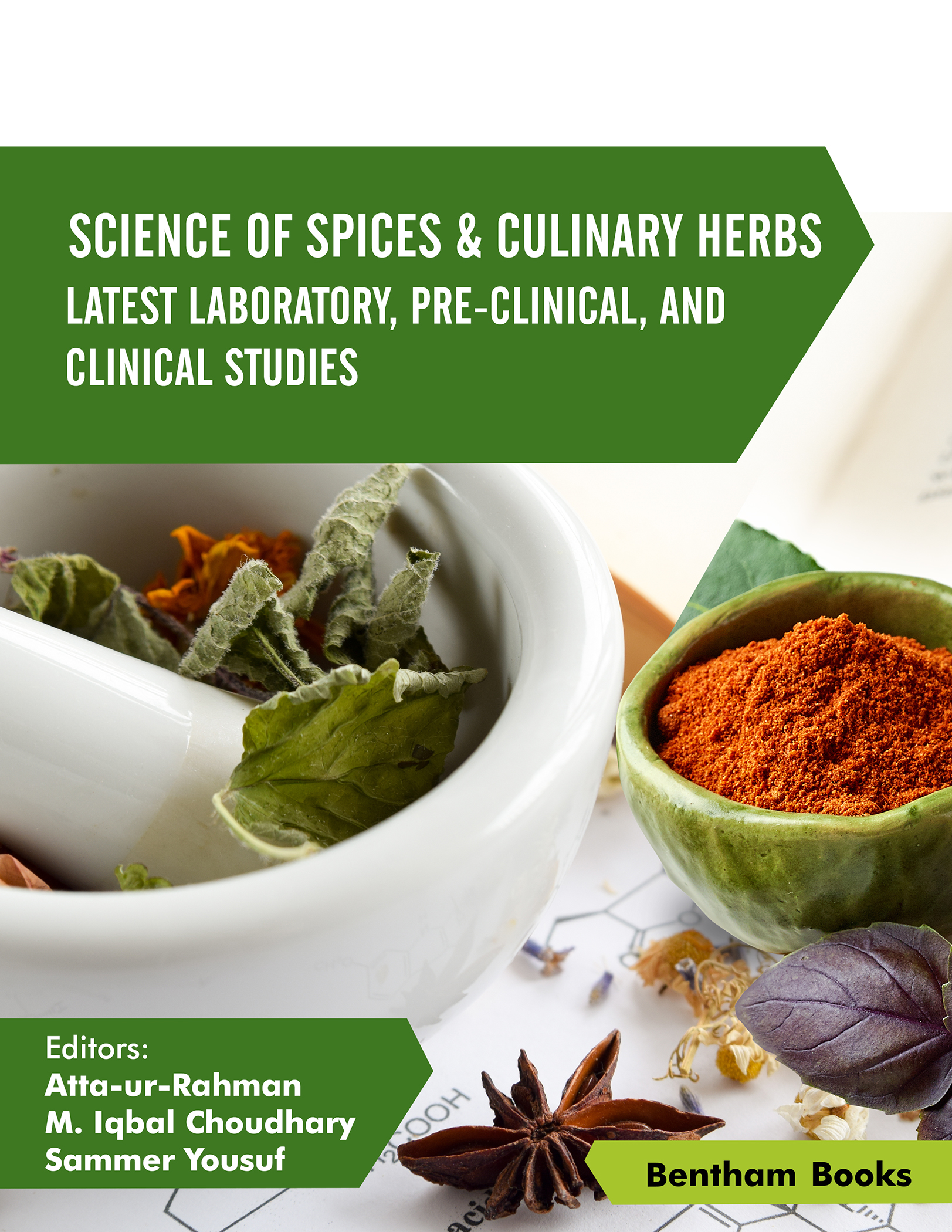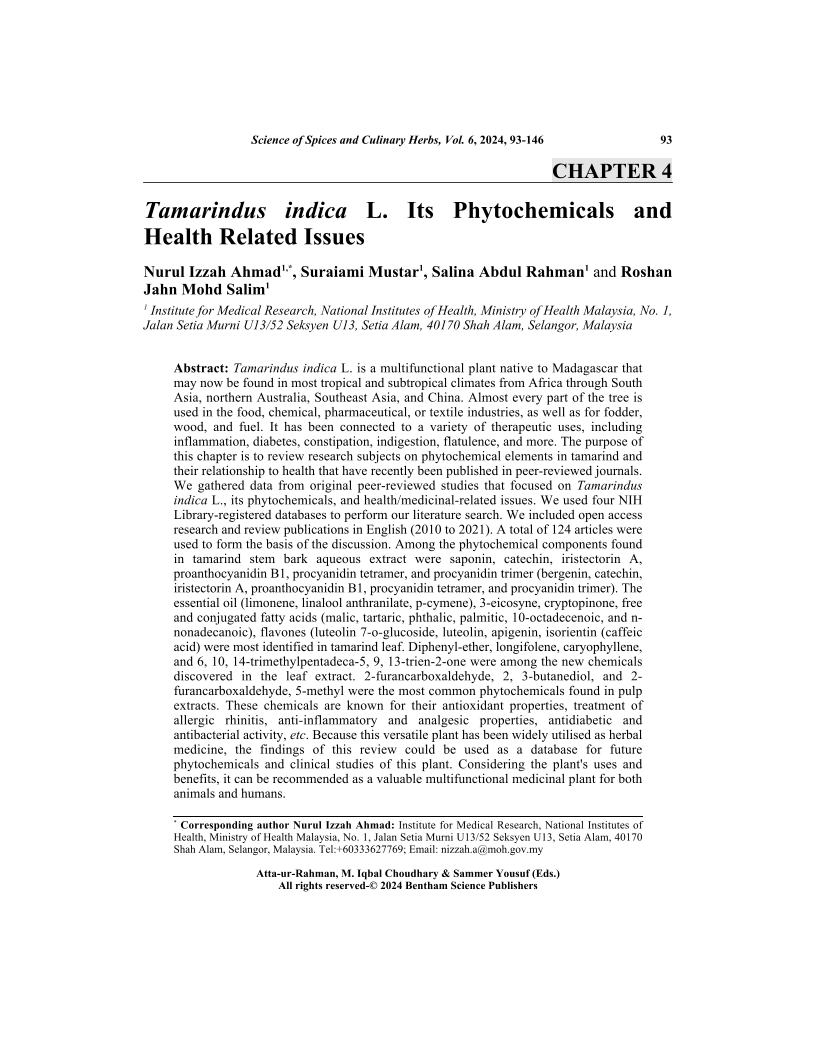- Home
- Books
- Science of Spices and Culinary Herbs - Latest Laboratory, Pre-clinical, and Clinical Studies: Volume 6
- Chapter
Tamarindus indica L. Its Phytochemicals and Health Related Issues

- Authors: Nurul Izzah Ahmad1, Suraiami Mustar2, Salina Abdul Rahman3, Roshan Jahn Mohd Salim4
-
View Affiliations Hide AffiliationsAffiliations: 1 Institute for Medical Research, National Institutes of Health, Ministry of Health Malaysia, No. 1, Jalan Setia Murni U13/52 Seksyen U13, Setia Alam, 40170 Shah Alam, Selangor, Malaysia 2 Institute for Medical Research, National Institutes of Health, Ministry of Health Malaysia, No. 1, Jalan Setia Murni U13/52 Seksyen U13, Setia Alam, 40170 Shah Alam, Selangor, Malaysia 3 Institute for Medical Research, National Institutes of Health, Ministry of Health Malaysia, No. 1, Jalan Setia Murni U13/52 Seksyen U13, Setia Alam, 40170 Shah Alam, Selangor, Malaysia 4 Institute for Medical Research, National Institutes of Health, Ministry of Health Malaysia, No. 1, Jalan Setia Murni U13/52 Seksyen U13, Setia Alam, 40170 Shah Alam, Selangor, Malaysia
- Source: Science of Spices and Culinary Herbs - Latest Laboratory, Pre-clinical, and Clinical Studies: Volume 6 , pp 93-146
- Publication Date: August 2024
- Language: English
Tamarindus indica L. is a multifunctional plant native to Madagascar that may now be found in most tropical and subtropical climates from Africa through South Asia, northern Australia, Southeast Asia, and China. Almost every part of the tree is used in the food, chemical, pharmaceutical, or textile industries, as well as for fodder, wood, and fuel. It has been connected to a variety of therapeutic uses, including inflammation, diabetes, constipation, indigestion, flatulence, and more. The purpose of this chapter is to review research subjects on phytochemical elements in tamarind and their relationship to health that have recently been published in peer-reviewed journals. We gathered data from original peer-reviewed studies that focused on Tamarindus indica L., its phytochemicals, and health/medicinal-related issues. We used four NIH Library-registered databases to perform our literature search. We included open access research and review publications in English (2010 to 2021). A total of 124 articles were used to form the basis of the discussion. Among the phytochemical components found in tamarind stem bark aqueous extract were saponin, catechin, iristectorin A, proanthocyanidin B1, procyanidin tetramer, and procyanidin trimer (bergenin, catechin, iristectorin A, proanthocyanidin B1, procyanidin tetramer, and procyanidin trimer). The essential oil (limonene, linalool anthranilate, p-cymene), 3-eicosyne, cryptopinone, free and conjugated fatty acids (malic, tartaric, phthalic, palmitic, 10-octadecenoic, and nnonadecanoic), flavones (luteolin 7-o-glucoside, luteolin, apigenin, isorientin (caffeic acid) were most identified in tamarind leaf. Diphenyl-ether, longifolene, caryophyllene, and 6, 10, 14-trimethylpentadeca-5, 9, 13-trien-2-one were among the new chemicals discovered in the leaf extract. 2-furancarboxaldehyde, 2, 3-butanediol, and 2- furancarboxaldehyde, 5-methyl were the most common phytochemicals found in pulp extracts. These chemicals are known for their antioxidant properties, treatment of allergic rhinitis, anti-inflammatory and analgesic properties, antidiabetic and antibacterial activity, etc. Because this versatile plant has been widely utilised as herbal medicine, the findings of this review could be used as a database for future phytochemicals and clinical studies of this plant. Considering the plant's uses and benefits, it can be recommended as a valuable multifunctional medicinal plant for both animals and humans.
-
From This Site
/content/books/9789815274370.chapter-4dcterms_subject,pub_keyword-contentType:Journal105


